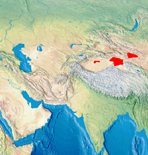|
Bactrian Camel at Giza Zoo
Class: Mammalia
Order:Artiodactyla
Family: Camelidae
Species:Camelus bactrianus |
Distribution:
It is native to north eastern Asia.
Habitat:
Bactrian camels inhabit arid regions. They are found along rivers in the Siberian steppe during winter but disperse into the desert when snows melt in spring. Temperatures range from -29 degrees Celsius in the winter to 38 degrees Celsius in the summer. |  |
Description:
Bactrian camel is unmistakable due to the two humps on its back, which essentially consist of lipid tissue. It is a very large animal with a body length of about 300 cm, a height (at the humps) of up to 230 cm, and a body-weight of up to 1000 kg.
The face is long and somewhat triangular, with a split, hairy upper lip. The nostrils can be sealed to keep out dust in the frequent sandstorms which occur in the camel’s arid habitat. The tail is about 50 cm long. The two broad toes on each foot have undivided soles and are able to spread widely as an adaptation to walking on sand.
The long, wooly coat varies in color from dark brown to sandy beige. There is a mane and beard of long hair on the neck and throat, with hairs up to 25 cm long. The shaggy winter coat is shed extremely rapidly, with huge sections peeling off at once, almost as if it were shorn off.
Lifespan:
Bactrian camels may live up to 50 years.
Diet:
Camels are herbivores. They are able to eat plants that are dry, prickly, salty, and/or bitter, but prefer any kind of vegetation. When other nutrient sources are not available, these camels may feed on bones, other animals' skin, or different kinds of flesh.
In more extreme conditions, they may eat rope, sandals, and even tents. Their ability to feed on a wide range of foods allows them to live in areas with sparse vegetation.
Behavior:
Wild Bactrian camels are active mainly during the day and are generally found alone or in small groups of more than 30 animals. A population density of 5 camels per 100 square kilometers has been calculated for Bactrian camels. They spend their time moving among grazing areas.
 | Reproduction:
Mating season occurs in the fall. Males during this time are often violent and may bite, spit, or attempt to sit on other male camels. The age of sexual maturity varies, but is usually reached at 3 to 5 years. Gestation lasts 13 months, with most young being born from March through April. One or occasionally two calves are produced.
Females can give birth to a new calf every year. Baby has the ability to stand and walk only a few hours of age. The young calf stays with its mother for three to five years, until it reaches sexual maturity. Wild camels sometimes breed with domesticated or feral camels as well. |
Conservation status:
IUCN Red List: Critically Endangered
References:
http://en.wikipedia.org/wiki/Camelus_bactrianus
http://animaldiversity.ummz.umich.edu/site/accounts/information/Camelus_bactrianus.html
http://www.iucnredlist.org/apps/redlist/details/63543/0
|